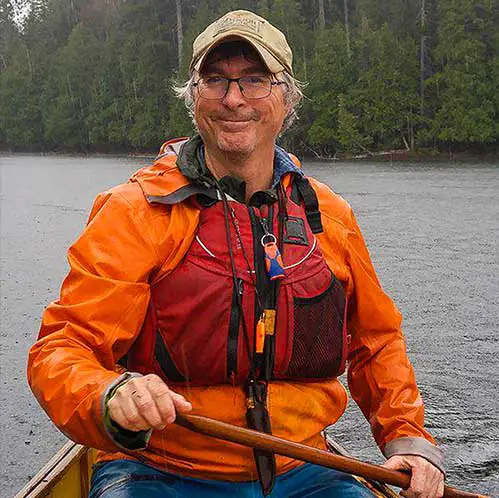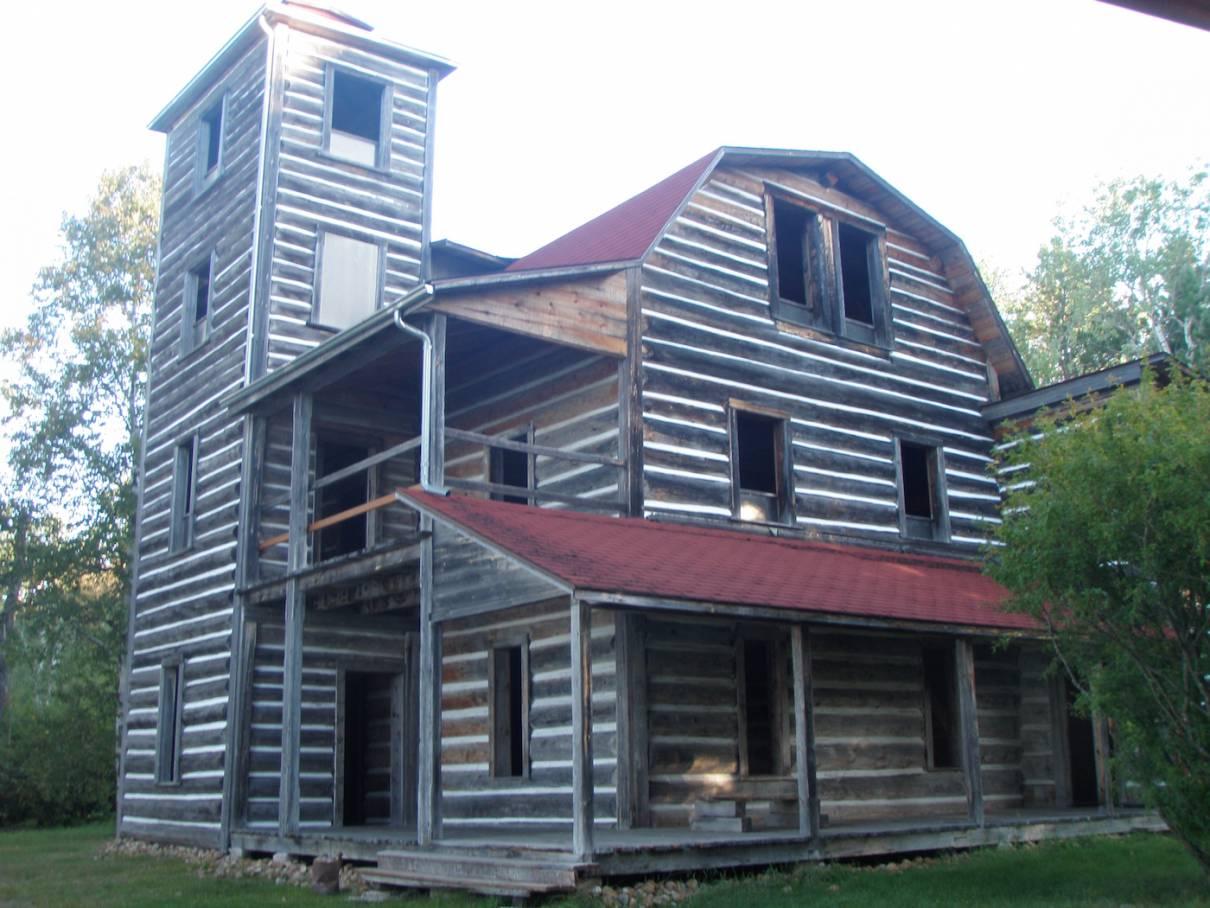There’s a lot of us who dream to live in the bush, alone and free from the business of suburbia. Whether we do it or not, the idea of it seems to be increasing. However, it’s definitely not new. People have been escaping into the woods for a long time now.
A few years back I had a magazine job writing up a narrative about some of the hermits who had escaped society and lived in the bush. It was a fascinating project and the characters were amazing individuals.
Jimmy McOuat’s White Otter Castle is one of the most intriguing hermitages of the northern bush. I first visited the site while paddling the Turtle River in northwestern Ontario in the mid-1990s. I certainly wasn’t the first to paddle there. The eight-by-twelve-metre log castle, built entirely by a sixty-year-old hermit decades earlier, has been a local draw for years. One of the first visitors was canoeist C.L. Hodson, who was working on an article for Rod and Gun magazine in 1914.
Mile after mile of rugged shoreline drops behind and then about 2:30 p.m. “Old Jimmy’s Place” quite suddenly slips into view. A hundred yards back from the lake it stands, on the edge of a small clearing. In the background are dark pine woods. No one speaks but with one accord the paddles pause here. Eyes strain. Heartbeats quicken. In the very air is mystery. Almost, we fear to approach this retreat of the wild man. We are intruders — trespassers. Then, slowly, the paddles dip. The bow grates on a strip of sandy beach. Gingerly we step ashore and approach the hermitage.
I felt a little gypped after reading about Hodson’s visit. Sure, the castle itself is impressive — standing four stories high and made of two hundred pine logs averaging sixteen-and-a-half metres long. But what made Hodson’s arrival better than ours was that “Old Jimmy” was home at the time. I think it would have been incredible to chat with such a man.
Countless stories are told of why Jimmy McOuat (pronounced McQuat) built the castle in the first place. The most poetic is that he had mail-ordered a bride from Scotland who canceled on the deal when she found out he lacked a proper house. So he built her the bizarre monument on the shores of White Otter Lake to prove the marriage was worth the trip from Scotland. As the story goes, however, she never did arrive to marry Jimmy.
During Hodson’s visit with Jimmy, he apparently asked him why he had built the castle, and the story is different than that of the Scottish bride. It seems it had to do with being falsely accused of throwing a corn cob at a bad-tempered schoolmaster. It was actually his school chum who had thrown the cob. For some reason, he was never able to forget the curse given out by the angry man: “Jimmy McOuat, ye’ll never do any good! Ye’ll die in a shack!” And, decades later, Jimmy found his accursed prophecy unfolding. After gambling his life savings away on a failed gold rush, he found himself on the shores of remote White Otter Lake (known then as Big Clearwater Lake), living in a shack. “All the time I lived in the shack,” Jimmy told Hodson, “I kept thinking — I must build me a house. And so I have. Ye couldn’t call this a shack, could ye.”
In 1918, four years after Hodson’s visit, Jimmy McOuat drowned while netting fish in front of the castle. His partially decomposed body, wrapped up in fish netting, was found the next spring by forest rangers and was buried beside his beloved wilderness home.
The Jimmy McOuat story emphasizes some of the reasons why individuals might choose to separate themselves from society. They’re treated as outcasts, and escaping into wilderness seclusion seems like a good idea at the time. Another example of this is Wendell Beckwith, an eccentric inventor who lived alone for twenty years on Wabakimi Provincial Park’s Whitewater Lake. His noted intention for doing so was to devote his life to “pure” research. The truth, however, was that he was escaping a troubled life back home in Whitewater Lake, Wisconsin.
I visited Wendell’s hermitage with film producer Kip Spidell and Ontario Provincial Park’s planner, Nancy Scott. It’s situated on Best Island in the southeast corner of Whitewater Lake. Our trip there was in the late 1990s, just before the cabins on site started showing signs of major deterioration and items began disappearing, taken by selfish visitors wanting souvenirs. There were three cabins and storage shed, all connected by a flagstone walkway and surrounded by a decorative cedar-rail fence. Each structure was designed perfectly, and every shingle and floorboard cut precisely. Elaborate carvings adorned all three entranceways, and pieces of the inventor’s scientific contraptions and scores of Ojibwe artifacts were scattered about. There was even a homemade telescope Wendell had made and a “lunar gun” (a device constructed to compute and predict lunar cycles and eclipses) resting beside the storage shed.
In 1955, after producing at least fourteen patents, most of them for the Parker Pen Company, Beckwith left his wife and five children behind in Wisconsin and began his solitary life on Whitewater Lake. The cabins didn’t actually belong to Beckwith. Harry Wirth, a San Francisco architect and developer, used the island site as a retreat and hired Wendell as a caretaker.
During Beckwith’s time here, he worked on various theories, ranging from the idea that the mathematical term pi recurred constantly in nature, to the idea that Whitewater Lake was incomplete triangulation with the Great Pyramids and Stonehenge — backing up his belief that Whitewater Lake was the “Centre of the Universe.”
The first of the three cabins is a split-level building known as the guest house or Rose’s Cabin. The modest structure is thought to have been the living quarters for Rose Chaltry while she visited Wendell Beckwith. Rose, Harry Wirth’s secretary, came to know Wendell and supported him financially after he had a major dispute with Wirth in 1975.
The main cabin, the only structure not completely designed by Beckwith, comes with its own icebox, which was lowered underground to keep food from spoiling, and a sizeable homemade birchbark canoe lashed to the south wall. This was where Beckwith stayed at first, but he soon found it far too showy and impractical. The massive stone fireplace was especially ineffective at heating the cabin during the long winter months, and he became concerned about his reduced hours of research.
By 1978, he had completed construction on the “Snail,” a circular cabin built directly into the side of a hill. The structure was far more heat- efficient, especially with a skylight centred above a sunken stove, equipped with a rotating conical shield to direct the heat and a pivoting chimney to allow for maximum draft. It was an environmental masterpiece.
Wendell Beckwith died of a heart attack in 1980, alone on a beach near the Snail. In the small cabin there’s a registry book resting on the table, and inside is an entry from Wendell’s daughter, Laura, dated August 6, 1997:
Very proud to be the daughter of such a man. I wish everyone could have seen his “domain” as it was while he was alive. By all accounts, he was an exceptional and extraordinary man whose ideas and theories we may never comprehend — but we can admire what he built here and the life he fashioned for himself. I last hugged him on the beach here — and I feel his presence still. Goodbye again, Dad.
Beckwith’s vision — to have a community of researchers living on the island in their own Snails, “cleaning their minds of mental parapher- nalia in the outside world” — may not have been a bad idea. Truly, he was not some mad scientist, but rather a Renaissance man who designed a perfect life for himself in this wild place of Wabakimi.
After witnessing so many hermitages during my time traveling in the north, I’ve come to realize that these individuals definitely are unique characters. After all, I doubt one could fake being a hermit. It would be like faking you were a quadriplegic. There’s undoubtedly a very dark side to the individual who chooses extensive solitude over living with a community. Most people are always drawn to a community. At times I think a hermit’s choice to live alone seems like a measure of redemption from the confines of society. They struggle to conform to all forms of authority, including their own personality. There’s even a hint of wickedness or even a warning of villainy.
There is also, however, a sense of magic and mystery to hermits; the fact that they’re superior to us, that they’re able to be far more connected to the wilderness than any “civilized” person who lives amongst the busyness of a city and who only escapes to the woods for a weekend retreat. That’s why some of us who travel for long periods of time in wilderness areas are usually intrigued rather than spooked when we hear the word “hermit.” It’s almost like we’re attracted to the vocation, that we revere the idea and are even hermits at heart.





